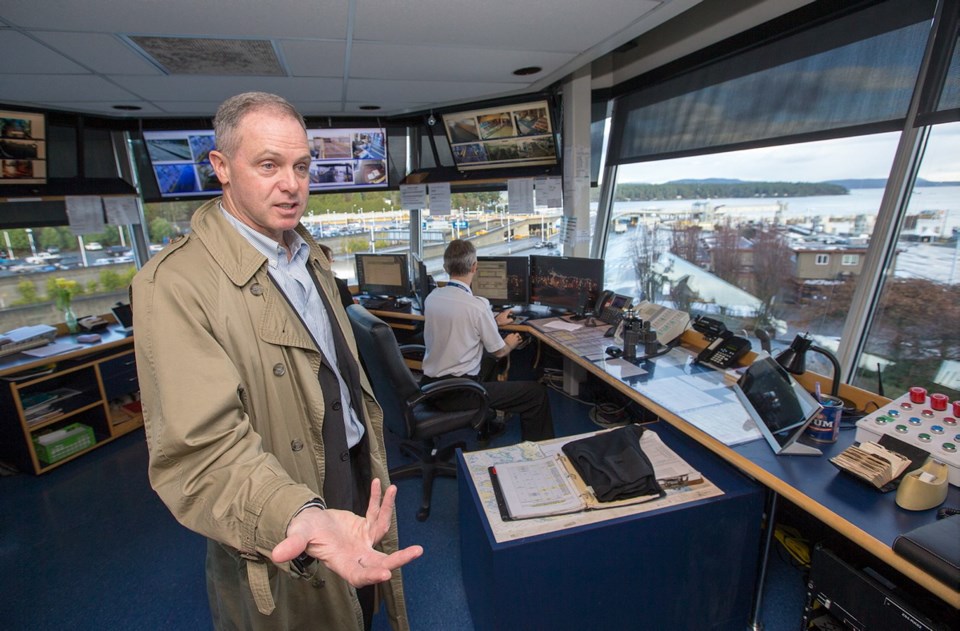B.C. Ferries intends to spend $2.3 billion on vessels and $1.3 billion on its terminals, including a renovation of Swartz Bay and a complete overhaul of Horseshoe Bay as part of a $3.9-billion capital plan.
It is the largest capital plan in B.C. Ferries’ history, and is designed to take pressure off a system that has essentially remained unchanged in 30 years, and is being taxed by near-record passenger demand.
The plan, outlining projected spending between 2019 and 2030, has been submitted to the B.C. Ferry Commission along with a traffic-demand forecast and strategy for enhancing efficiency in order to help the commission establish fare price caps for all B.C. Ferries routes.
Mark Collins, chief executive of B.C. Ferries, said while the plan represents a significant investment, it is not excessive, and it allows the corporation to live up to its vision of being a reliable and resilient operation.
Collins said B.C. Ferries is moving away from seeing itself as just a transportation provider and more of an entity that connects communities. “If our vision has changed, what do we need to do to live up to that vision?” he said, noting two things come to mind — increasing capacity on the system and improving its resiliency. “Do we have enough assets and systems and people and infrastructure that we can roll with difficulties?”
This year, the answer was sometimes no.
Losing Queen of Cumberland for nearly a month in the spring due to an equipment failure exposed a weakness in the system and was a major disruption for service in the Gulf Islands, Collins acknowledged.
The corporation is under pressure to expand its capacity.
Collins said they recorded a new all-time high for vehicle traffic last year, while flirting with a new record for passenger numbers. This year, the corporation could exceed both.
“We are putting more traffic through this network than ever before and we’ve had no real increase in capacity in nearly 30 years. It’s essentially the same system as in 1990,” he said. “We are approaching the physical limits of the system in some areas.”
According to a traffic study, included in the B.C. Ferries submission, the corporation has recorded six consecutive years of traffic growth and has seen a 14 per cent increase in vehicle traffic over the last four years.
In the last year, B.C. Ferries carried 22 million passengers and 8.7 million vehicles, which the corporation said limits its ability to expand capacity in its current state. Collins believes the capital plan contains measures that will address those issues.
The plan outlines B.C. Ferries’ intention to renew 19 of the system’s 36 vessels over the next 14 years, while cutting down the number of vessel classes to increase standardization around the fleet.
“It is more than just replacement, it’s not like-for-like, it’s about moving to a cleaner, low-carbon future and about more capacity,” said Collins, noting on some routes, a medium vessel will be replaced by two small vessels, which will improve resiliency, frequency and capacity.
B.C. Ferries also intends to add a 12th vessel to the major routes. Currently, 11 major vessels are plying the waters between Vancouver Island and the mainland.
But ship replacement takes time — three to five years.
Collins said B.C. Ferries has a software change that could alleviate some capacity issues as early as next summer.
Despite carrying more traffic than ever, and being swamped during the summer months, B.C. Ferries runs at 70 per cent capacity annually.
“So there is capacity there, but it’s at times people don’t much care for,” he said. “What the software will do is allow us to put incentives into the market to encourage people to travel at off-peak times.”
That new system — part of the $300 million earmarked for information technology over the course of the plan — went live inside B.C. Ferries this year and will be available to customers in late spring, when a new website is launched.
Soon after that, B.C. Ferries will introduce variable rates designed to shift traffic to under-utilized sailings.
In conjunction with new software and new vessels, B.C. Ferries has big plans for some of its 47 terminals.
The biggest project will be at Horseshoe Bay, which is expected to start in 2023 and take at least three years to complete. “That’s the Big Kahuna,” said Collins. “It’s a perennial choke point.”
Horseshoe Bay is the corporation’s busiest terminal in terms of sailings and vessel movements, though it’s less than half the size of its Tsawwassen terminal.
The plan is to replace marine structures and redesign the vehicle and passenger holding areas, while continuing to operate.
“That will be pretty challenging but it’s our commitment to get [people] through and keep the ferries on time,” said Collins.
There are plans to update Swartz Bay’s amenities and waiting areas starting in 2021, and to expand the terminal’s Berth 3 to be able to accommodate a major vessel. That project is expected to take about a year.



